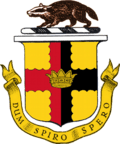Sarawak State Museum
| Muzium Negeri Sarawak | |
|
| |
| Established | 1888 |
|---|---|
| Location | Kuching, Sarawak, Malaysia |
| Coordinates | 1°33′17″N 110°20′37″E / 1.55472°N 110.34361°ECoordinates: 1°33′17″N 110°20′37″E / 1.55472°N 110.34361°E |
| Type | Ethnology museum |
| Founder | Charles Brooke |
| Owner | Sarawak state government |
| Website |
www |
The Sarawak State Museum (Malay: Muzium Negeri Sarawak) is the oldest museum in Borneo. It was founded in 1888 and opened in 1891 in a purpose-built building in Kuching, Sarawak. Naturalist Alfred Russel Wallace encouraged Charles Brooke, the second White Rajah of Sarawak, to establish the museum.
History


The Sarawak Museum was built in 1891 and was extended to its present form in 1911. The building was built to permanently house and display local indigenous arts and crafts, and collections of local animals. Its founding was encouraged by the prominent British naturalist, Alfred Russel Wallace, who was then collecting specimens in the state.
The museum was run by military officers during the two world wars. In the Great War, British officers were assigned to it. During the Japanese Occupation of World War II, the museum was directed by a Japanese officer, who was sympathetic to its goals. He protected it and the museum suffered very little damage or looting.
The historic building has been renovated. It is used to exhibit and interpret collections on the natural history of Sarawak. Shell Oil sponsored an exhibit on the petroleum industry, which has been important to Borneo. In addition, it displays archaeological artefacts and reconstructions of examples of traditional life of the indigenous peoples, and of their arts and crafts. It has the most comprehensive archaeological, natural history, and ethnographic collections on Borneo.
Architecture
The building has undergone several renovations and alterations since its construction. It is rectangular, 44’ × 160’ with walls and pillars of bricks, and roof of belian and concrete. The Sarawak Gazette referred to it being in the Queen Anne style. It is likely that Rajah Charles saw a picture of the Adelaide Children's Hospital [1] and directed his staff to produce a Museum to look like it. The museum is very similar but without the central spire.[2] The galleries are lighted by dormer windows on the roof, making wall space available for exhibit displays and collections.
Layout

The ground floor of the museum holds the natural history collection and specimens of Sarawak fauna — reptiles, mammals, birds, etc., all expertly prepared and mounted for display. The west wing of the museum houses the Shell exhibition on the petroleum industries of Sarawak.
The first floor has exhibits of ethnographic artefacts of the indigenous peoples, such as models of the various types of longhouses, musical instruments, various kinds of fish and animal traps, handicrafts, models of boats and others.
Museum journal
The Sarawak Museum Journal is published by the museum staff. It was first published in 1911, with John Moulton the inaugural editor, making it one of the oldest scientific journals of the South-East Asian region. Topics covered include the history, natural history and ethnology of the island of Borneo.
Curators and directors

Until 1974, the head of the museum was termed "Curator":
- J.E.A. Lewis — Pro tem Curator, acting from 25 June 1888 – 1902
- Dr George Darby Haviland — 26 February 1891 – 1 March 1893
- Edward Bartlett — 1 March 1893 – 22 July 1897
- Robert Walter Campbell Shelford — 22 July 1897 – 2 February 1905
- John Hewitt — 2 February 1905 – November 1908
- John Coney Moulton — November 1908 – 22 January 1915
- Mr Erman & K. H. Gillan — Officers in charge, 22 January 1915 – May 1922 (during WWI)
- Dr Eric Georg Mjöberg — May 1922 – 19 December 1924
- Gerard T.M. MacBryan — Acting Curator, 20 December 1924 – 24 January 1925
- Edward Banks — 20 February 1925 – 1945 (1942–1945 interned)
- Tom Harrisson — June 1947 – November 1966
- Benedict Sandin — December 1966 – March 1974
After this, "Director" was the title for the head of the museum:
- Lucas Chin — 1 April 1974 – December 1991
- Dr Peter M. Kedit – December 1991 – April 1996
- Sanib Said — May 1997 - December 2008
- Ipoi Datan - January 2009 – Present
See also
| Wikimedia Commons has media related to Sarawak State Museum. |
Literature
- Lenzi, Iola (2004). Museums of Southeast Asia. Singapore: Archipelago Press. p. 200 pages. ISBN 981-4068-96-9.
References
- ↑ "Original Children's Hospital Samuel Way Building".
- ↑ Patrica, Hului (7 August 2015). "Tracing the designs behind the Sarawak Museum". The Borneo Post. Archived from the original on 9 August 2015. Retrieved 9 August 2015.
- "Curators", Sarawak Museum Official Website, Accessed 9 July 2015
